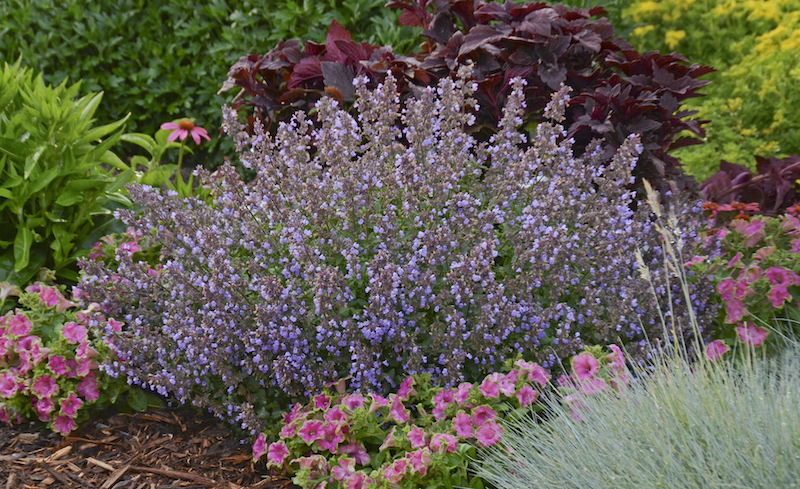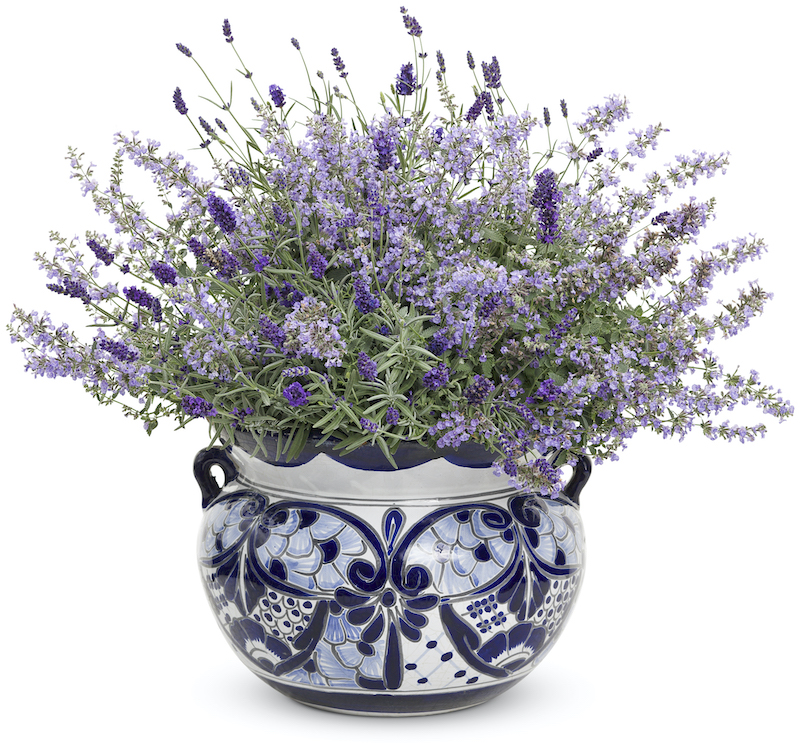Growing Catmint
Catmint (Nepeta x faassenii) is a highly fragrant ornamental perennial that is often confused for Catnip (Nepeta cataria). Both plants are part of the lamiaceae, or mint, family and both are attractive to cats. The easiest way to tell the difference is by the color of the flowers. Catnip has white flowers and catmint always has blue or purple blooms. Catmint is very useful as an edging plant to line a driveway or sidewalk because it is tough, drought tolerant, and loves the hot spots where most other plants fail to survive.
This long-lived perennial also takes colder temperatures in the winter and makes a nice replacement for Lavender in zones where they are not fully hardy. There are over 250 cultivated varieties of Catmint in a range of sizes from 10 inches tall to 4 feet. The long-lasting blooms can also be used as a scented filler for cut flower arrangements. Catmint is one plant that really seems to thrive on neglect once it is mature.

Planting Catmint
Catmint should be planted in a spot that has full sun and well-draining soil that isn't heavy or overly fertile. Growing Catmint in containers is also a good option for gardens in small spaces. Always plant perennials at the same depth they were growing in the nursery pot. Digging the plants in too deep will cover the crown of the plant and either inhibit flowering or cause the plant to slowly rot from lack of air to the crown.
Dig the planting hole twice as wide as the pot, and gently tease the root ball loose so that the roots will spread out in the soil and give the plant a nice stable base. Always water Catmint well after planting to help settle soil around the roots and eliminate any large air pockets.
Watering Catmint
Watering is crucial for any perennial the first year or two before they have matured and established a strong root system. Signs that plants may need extra watering are droopy leaves and flower stems, and leaves turning brown and/or getting crispy. Watering is best done early in the day when the soil will absorb all of the moisture, losing little to evaporation of the sun or hot temperatures. Using drip irrigation or soaker hoses is the most efficient way to get water where the plant will use it, at the root zone.
Initially, watering Catmint 2-3 times a week with around ½ inch of water will help the roots stay sufficiently moist. In following years, the frequency of watering can be reduced to once a week or even less as the plant becomes more drought tolerant. Frequent, shallow watering encourages the roots to remain too close to the surface of the soil, allowing the roots to dry quickly. Deep watering, less often, will encourage the roots to seek moisture deeper in the soil and be able to withstand periods of heat and drought better.
Fertilizing Catmint
Catmint is a perennial that requires very little extra fertilizing to encourage heavy flowering or vigorous blooming. Often, an annual mulching of organic compost is all that is needed to provide nutrition for the whole growing season. The best time to apply a mulch of compost is early in the spring as the new growth appears. The soil is warm enough to use the nutrients, as they slowly absorb down into the ground.
A commercial granular slow-release fertilizer can also be used early in the spring. Slow-release feeds only need to be applied once a year to be of maximum benefit. Liquid fertilizers should only be used on container-grown plants that need the extra nutrition. Supplemental fertilizing should end around the beginning of August so the plant has a chance to harden off before it goes dormant for the winter.
Pruning Catmint
Pruning is one way to make sure that Catmint doesn't start to be overgrown through the summer. Some varieties need to be cut back by the end of June to maintain a compact appearance. Cut the plants back by half of their height so that a new flush of bushier growth and flowers can develop. Some of the larger varieties of Catmint will get floppy and top heavy no matter how much sun or water they receive. Using very sturdy stakes or plant hoops will keep the plant upright through blooming.
The foliage will die back in the fall and can be pruned anytime before new growth starts in the spring. Cut the plants to within 4-6 inches of the ground. Catmint may remain semi-evergreen in warmer hardiness zones. In those areas, pruning out the dead and damaged growth from the previous year is done early in the spring.
Caring For Catmint in Pots
Catmint grows easily in containers and mixes well with other summer-blooming annuals such as Calibriocha, Sweet Potato vine and trailing Verbena. Regular watering is very important for perennials grown in containers. Make sure that the soil dries out 2-3 inches below the soil surface and that the drainage is excellent in the bottom of the pot. Water until it starts to flow out of the bottom of the pot. This ensures that all of the soil is evenly moist, not just the top layer.
Regular watering will unavoidably leach nutrients out of the planting soil. Regular fertilizing with a diluted liquid feed will replace any nutrients the plant needs. Generally, most liquid feeds should be applied once a month until August for the best growth. Container-grown Catmint might need to be moved to a spot that has good drainage or put up on bricks or ‘pot feet’ so that excess winter rains will not waterlog the plant.

Winter Care for Catmint
Catmint grown in the garden needs very little care for the winter. It is an herbaceous perennial that goes completely dormant for the winter and regrows from the base each spring. Fall clean-up can include cutting Catmint back to 4-6 inches above the ground and then mulching with leaves, finely shredded bark or organic compost. Always be careful to keep the mulch off the center crown of the plant. Only mulch around the base to insulate the roots well. Leaving the plant’s stems in place over the winter will help to protect the crown from excess moisture and harsh winds.
Common Questions About Catmint
Is Catmint Edible?
Just like other mint family plants, Catmint is edible and not considered toxic for humans or pets. If large amounts are eaten, it can cause stomach upset, but rarely any other problems. Some people or pets may have reactions to the oils on the foliage and may experience contact dermatitis.
Is Catmint Invasive?
Catmint does not have invasive roots like other members of the Mint family, but it does grow vigorously.
Is Catmint An Annual Or Perennial?
Catmint is a perennial that prefers well-drained and light soil that is not overly fertile. Flowering starts late in the spring and can continue through the early fall.
Why Are Catmint Leaves Turning Yellow, Brown, and/or Black?
It may be caused by standing water in the soil. Excess water accumulation in soil- suffocates the roots and can affect root growth and cause leaves to turn yellow. Also may be caused by a disease called Bacterial leaf spot disease. Bacterial leaf spot disease is commonly seen in cold weather conditions.
What Is The Growth Rate Of Catmint?
In one season, Catmint can spread up to 3 feet so give it plenty of space and divide it every three to four years.
Is Catmint Drought Tolerant?
Catmint is tough and drought tolerant and loves the hot spots where most other plants fail to survive.
Have a question about Catmint? Fill out the form below and we will try and get back to your question as soon as possible. We may even feature your question in this article to help other gardeners!
 |
Author Robbin Small - Published 7-14-2022 |
